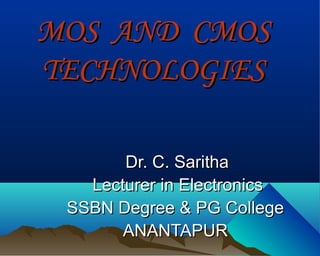
Mos and cmos technology
- 1. MOS AND CMOS TECHNOLOGIES Dr. C. Saritha Lecturer in Electronics SSBN Degree & PG College ANANTAPUR
- 2. OVERVIEW:- Introduction. MOS (Metal-oxide semiconductor). CMOS (Complimentary metal- oxide semiconductor). Advantages. Characteristics.
- 3. INTRODUCTION:- The field-effect transistor (FET) is a unipolar transistor. There are two types of field-effect transistors. There are junction field-effect transistor (JFET) and metal oxide semi-conductor (MOS).
- 4. Metal gate has been replaced by polysilicon or poly in modern technologies. There are two types of MOS transistors: nMOS : Negatively doped silicon, rich in electrons. pMOS : Positively doped silicon, rich in holes.
- 5. CMOS:- Both type of transistors are used to construct any gate. The former is used in linear circuits and the latter in digital circuits. MOS transistors can be fabricated less area than bipolar-transistors
- 6. Basic structure of MOS transistor
- 7. P-channel MOS consists of a lightly doped substrate of n-type silicon material. Two regions are heavily doped by diffusion with p-type impurities to form the source and drain. The region between the two p-type sections serves as the channel.
- 8. As the magnitude of the gate negative voltage on the gate increases, the region below the gate accumulates more positive carriers. The conductivity increases, and current can flow source to drain. Provide a voltage difference between these two terminals.
- 9. The mode of operation can be enhancement or depletion, depends on the state of the channel region at There are four basic MOS structures. The channel can be a p-type or n-type ,depending on whether the majority carriers are holes or electrons. The mode of operation can zero voltage.
- 10. If the channel is initially doped lightly with p-type impurity, a conducting channel exits at zero gate voltage and the device is said to operate in the depletion mode. In this mode current flows unless the channel is depleted by an applied gate field.
- 11. If the region beneath the gate is left initially uncharged, a channel must be indused by the gate field before current can flow. Thus, the channel current is enhanced by the gate voltage and such a device is said to operate in the enhancement mode.
- 12. P-channel:- The source is the terminal through which the majority carriers enter the bar. The drain is the terminal through which majority carriers leave the bar. When the gate voltage is above threshold voltage (about -2v),no current flows in the channel.
- 13. P-type carriers are positive and correspond to a positive current flow from source to drain. N-channel:- In the channel MOS, the source terminal is connected to the substrate and a positive voltage is applied to the drain terminal.
- 14. When the gate voltage is below the threshold voltage (about 2v). N-type carriers flow from source to drain. N-type carriers are negative, which corresponds to a positive current flow from drain to source.
- 15. Graphical symbols for MOS transistor:-
- 16. The symbol for the enhancement type is the one with the broken-line connection between source and drain. Source to drain is the p-channel. And the drain to source is the n-channel.
- 17. N-channel MOS logic circuits using NAND gate:
- 18. Working:- NAND gate uses transistor in series. The inputs A and B both high for all transistors to conduct and cause the output go low. If either input is low ,the corresponding transistor is turned off and the output is high.
- 19. Advantages :- The enhancement type MOS devices have been used as micro-resistors in integrated microcircuits. It is easier to fabricate MOSFET. It is widely used than JFET. The enhancement type MOSFET finds wide application in digital circuitary.
- 20. Complimentary mos CMOS:- Complimentary MOS (CMOS) circuits take advantage of the fact that both p-channel and n-channel devices can be fabricated on the same substrate. CMOS circuits consist of both types of MOS devices, interconnected to form logic functions.
- 21. CMOS LOGIC CIRCUIT USING NAND GATE:
- 22. The output has low impudence to ground and produces a low state. If any input is low: The n-channel transistor is turn off and the associated p-channel transistor s is turned on. The output is coupled to VDD and goes to the high state.
- 23. WORKING:- A two input NAND gate consists of two p- type units in parallel and two n-type units in series. If all inputs are high:- If all inputs are high,both p-channel transistors turn off and both n-channel
- 24. Multiple- input NAND gates may be formed by placing equal number of p-type transistors and n-type transistors in parallel and series, respectively.
- 25. CMOS CHARACTERISTICS:- Power dissipation is very low 0.01mw. The propagation delay time 5v ranges from 5 to 20ns. Higher fan-out. Good noise immunity. The noise margin is usually about 40 percent of the power supply voltage.
- 26. THANK YOU
